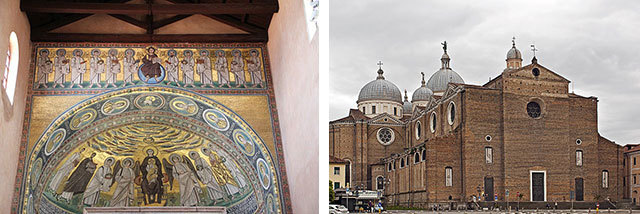
TOPICS:
Saint Justina of Padua
Aug 27, 2021 / Written by: Tonia Long
Feast October 7
Virgin and Martyr

St. Justina of Padua was a virgin of noble birth. Born at Padua about the middle of the first century, her father Vitalian was a rich nobleman and prefect of Padua. Her parents were converted to Christianity by the preaching of Saint Prosdocimo. Having suffered from infertility their entire married life, the new converts fervently prayed for a child. They received Justina in answer to their prayer.
She was devoted to religion from her earliest years and ultimately she took the vow of perpetual virginity. At this time arose the persecutions of the Christians by Nero, and Maximian the prefect who had succeeded Vitalian, proved himself particularly vicious.
As Justina would visit the prisons to comfort and encourage the Christians there, Maximian ordered her arrest. While she was passing by the Pont Marin near Padua she was seized by the soldiers. When she was brought before Maximian he was struck by her beauty and endeavored by every means to shake her constancy. However, she remained firm against all attacks and the prefect caused her to be slain with the sword.
Justina is represented in Christian Art crowned as a princess, and with a sword transfixing her bosom, in accordance with her martyrdom, 303 A.D.
Veneration
St. Justina is a patron saint of Padua. After St. Mark, she is also a second patroness of Venice. Her feast day is October 7 and coincided with the end of grape harvest and the time for settling agricultural contracts.
In the 6th century the Paduans dedicated a church to her and she was among the virgin martyrs portrayed in the presbytery arch in the Euphrasian Basilica and in the procession of virgins in Sant'Apollinare Nuovo. In the 7th century, Venantius Fortunatus, writing in Gaul, urged travelers to Padua to visit her relics there.
The Paduan Basilica and Abbey of Santa Giustina houses the Martyrdom of St. Justine by Paolo Veronese. The Abbey complex was founded in the 5th century on Justina's tomb, and in the 15th century became one of the most important monasteries in the area, until it was suppressed by Napoleon in 1810. In 1919 it was reopened. The tombs of several saints are housed in the interior, including those of Justina, Prosdocimus, St. Maximus, St. Urius, St. Felicitas, St. Julian, as well as relics of the Apostle St. Matthias and the Evangelist St. Luke.

Header Image: Martyrdom of Saint Justina by Giulio Cesare Procaccini. Procaccini was an Italian painter and sculptor of the early Baroque era in Milan. Princeton University Art Museum
